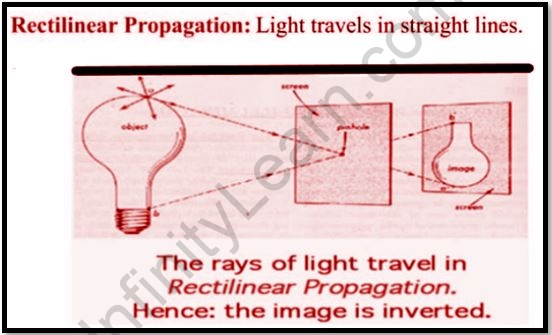
Courses

By Shailendra Singh
|
Updated on 4 Dec 2024, 12:02 IST
What is rectilinear propagation of light? The tendency of Electromagnetic waves (light) to flow in a straight path is known as rectilinear propagation. When light travels through a homogeneous substance with the same refractive index throughout, it does not deviate; otherwise, light refracts. Individual rays are travelling in straight lines, even if a wavefront is curved. Pierre de Fermat was the first to discover rectilinear propagation. When looking at a light source through a long pipe having apertures on both ends, for example, the light source is clearly apparent. If we bend this pipe so that it is no longer straight and then try and look at the light source, we will see that it is no longer visible.
Take three identically sized cardboard A, B, and C. Make a pinhole in the middle of each of the three cardboard pieces. Place the cardboard in an upright posture so that the holes in A, B, and C are in a straight line in the order they appear. Look through the hole in cardboard C while holding a bright source such as a candle near cardboard A. The candle flame is visible. This means that light rays go in a straight-line ABC, resulting in the appearance of a candle flame. Candlelight would not be visible if one of the cardboard pieces was slightly misplaced. It indicates that the candle’s light is unable to curve and reach the observer’s eye.
Let’s use water as an example to demonstrate that light can flow through other transparent media. Fill a glass with water and dip a portion of one of your fingers into it. The finger can still be seen, but it has been bent and looks to be smaller. The refraction of light is a phenomenon in which light bends in such a way that it generates the illusion of an elevated body or a shorter hand in the water. The twinkling of stars in the sky is another natural example of this phenomenon. Due to differences in densities of the different layers of the atmosphere, light from the stars is refracted in the atmosphere, giving the appearance of twinkling even when it is not.
Rectilinear refers to a line that is straight.
The term “propagation” refers to the movement of light.
Rectilinear propagation of light is the property of light traveling in straight lines in a homogeneous transparent medium. Light does not bend in any way. You won’t be able to see around a corner because of this.

The manipulation of light by positioning an object in its path its density differs from that of the surrounding medium is known as refraction. This causes light to either slow down or speeds up, changing its direction in the process.

The bouncing of light off an item is known as reflection. If you set a mirror in a corner, light from all over the corner will bounce off the mirror and travel towards your eyes, allowing you to “see” around the corner.
In a dark room, sunrays entering through a small hole appear to go in a straight line.
The light from the torch, car headlights and other sources appears to follow a straight path.
In the form of light rays, light from a projector flows in a straight line towards the screen.
The laser pointer’s light appears to move in a straight-line path.
The term “light” refers to a type of energy.

Light can take on the form of a wave or a particle.
Light travels in a straight line at all times. The rectilinear propagation of light is the name for this characteristic.
The propagation of light does not involve the use of any medium. It’s even capable of travelling into a vacuum.
In air or vacuum, it travels at an extremely high velocity of roughly 3*108 m s–1.
The qualities of the medium by which light flows are unaffected.
As light moves from a rarer to a denser medium, its velocity reduces.
Visible light, which includes the hues of the rainbow, is only a small part of the electromagnetic spectrum.
The solar eclipse occurs when the moon passes between the sun and the moon, blocking the sun’s light path and casting a shadow.
You can see yourself when you stand in front of a mirror, which is due to the reflection of light on the mirror.
When a stick is submerged in water, the section that is submerged seems bent but is still visible.
To put it another way, the 12th syllabus carries 60 percent weightage in JEE MAINS, whereas the class 11th syllabus has 40 percent weightage. Around 5% of the total is devoted to the topic of rectilinear light propagation under the light in a straight line. This subject is frequently tested on 4 to 5 questions each year. It will not only help you grasp the concepts better, but it will also help you remember them for longer.
FAQs on Rectilinear Propagation of Light
Rectilinear light propagation is a natural phenomenon that permits light to move in a straight line without being obstructed. When light cannot pass via a channel that is blocked by solid or opaque substances, shadows result.
When light strikes a smooth opaque material like a mirror, it reverses its direction of propagation and bounces back.
When light travels through different materials, its direction of propagation is deflected due to changes in the densities of the mediums. As a result, when it finally reaches our eyes after bouncing off of anything, the item appears.